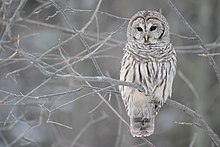
Back بومة مخططة Arabic بومه مخططه ARZ Strix varia AST Əlvan yapalaqca Azerbaijani Северноамериканска улулица Bulgarian Gamarús ratllat Catalan Strix varia CEB Puštík proužkovaný Czech Tylluan resog Welsh Streifenkauz German
| Barred owl | |
|---|---|

| |
| Scientific classification | |
| Domain: | Eukaryota |
| Kingdom: | Animalia |
| Phylum: | Chordata |
| Class: | Aves |
| Order: | Strigiformes |
| Family: | Strigidae |
| Genus: | Strix |
| Species: | S. varia
|
| Binomial name | |
| Strix varia Barton, 1799
| |
| Subspecies | |
| |

| |
| Synonyms | |
|
Syrnium varium | |
The barred owl (Strix varia), also known as the northern barred owl, striped owl or, more informally, hoot owl or eight-hooter owl, is a North American large species of owl. A member of the true owl family, Strigidae, they belong to the genus Strix, which is also the origin of the family's name under Linnaean taxonomy.[3][4] Barred owls are largely native to eastern North America, but have expanded their range to the west coast of North America where they are considered invasive.[1][5][6] Mature forests are their preferred habitat, but they can also acclimatise to various gradients of open woodlands.[7] Their diet consists mainly of small mammals, but this species is an opportunistic predator and is known to prey upon other small vertebrates such as birds, reptiles, and amphibians, as well as a variety of invertebrates.[8]
Barred owls are brown to gray overall, with dark striping on the underside. Barred owls have typical nesting habits for a true owl, tending to raise a relatively small brood often in a tree hollow or snag (but sometimes also in other nesting sites) in forested areas.[9] As a result of the barred owl's westward expansion, the species has begun to encroach on the range of the related and threatened spotted owl (Strix occidentalis). Evidence shows the assorted threats posed by the invading barred species are only increasing. In response, biologists have recommended culling operations to mitigate the negative effect of the barred on the spotted owl species.[10][11]
- ^ a b BirdLife International (2016). "Strix varia". IUCN Red List of Threatened Species. 2016: e.T22689094A93217844. doi:10.2305/IUCN.UK.2016-3.RLTS.T22689094A93217844.en. Retrieved 12 November 2021.
- ^ "Appendices | CITES". cites.org. Retrieved 2022-01-14.
- ^ Sclater., P. L. (2008). "Remarks on the Nomenclature of the British Owls, and on the Arrangement of the Order Striges". Ibis. 21 (3): 346–352. doi:10.1111/j.1474-919X.1879.tb07718.x.
- ^ Konig, Claus; Weick, Friedhelm; Becking, Jan-Hendrick (1999). Owls: A Guide to the Owls of the World. Yale University Press. pp. 327–328.
- ^ Evers, L. (2014). Beyond anyone's control. Northwest Science, 88(1), 65–67.
- ^ Kelly, E. G. (2001). The range expansion of the northern barred owl: an evaluation of the impact on spotted owls. Thesis, Oregon State University.
- ^ Mazur, K. M. & James, P.C. (2020). "Barred Owl (Strix varia)", version 1.0. In Birds of the World (A. F. Poole and F. B. Gill, Editors). Cornell Lab of Ornithology, Ithaca, NY, USA.
- ^ "Barred Owl". Audubon. 2014-11-13. Retrieved 2017-09-01.
- ^ Voous, Karel H.; Cameron, Ad (illustrator) (1988). Owls of the Northern Hemisphere. London, Collins. pp. 225–230. ISBN 978-0-00-219493-8.
- ^ Buchanan, Joseph B.; Gutiérrez, R. J.; Anthony, Robert G.; Cullinan, Tim; Diller, Lowell V.; Forsman, Eric D.; Franklin, Alan B. (2007). "A synopsis of suggested approaches to address potential competitive interactions between Barred Owls (Strix varia) and Spotted Owls (S. occidentalis)". Biological Invasions. 9 (6): 679–691. Bibcode:2007BiInv...9..679B. doi:10.1007/s10530-006-9068-7. S2CID 20935420.
- ^ Livezey, K. B. (2010). "Killing barred owls to help spotted owls I: a global perspective". Northwestern Naturalist. 91 (2): 107–133. doi:10.1898/NWN09-37.1. JSTOR 40856470. S2CID 11691153.
